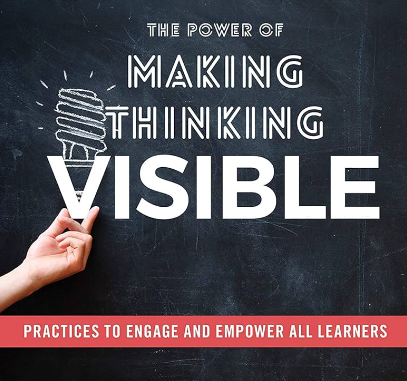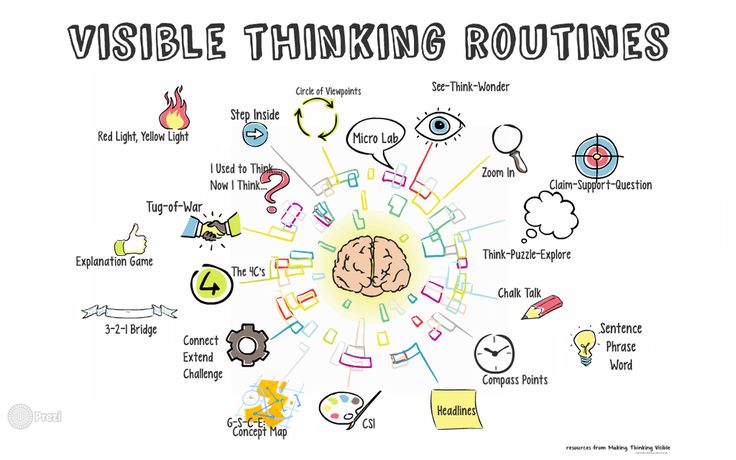
The Power of Making Thinking Visible

“When students realize their thinking forms the basis of your interactions with them, they are more likely to experience thinking routines as purposeful patterns of behavior that have meaning for their learning.” (Ritchhart & Church)
Hello readers! Making Thinking Visible or MTV is an awesome concept. One I feel as though a lot of teachers do without the intention of making thinking visible. Once we add the intention and are able to see how we can connect the dots, students are going to begin to see their learning come to life!
- Engagement of students in their own learning. Teaching and learning happens in meaningful ways everyday. Through these various ways we see student engagement. Not only is it a part of the learning but also ques teaches into how well students are understanding the materials. Challenging students to see learning for themselves and their community. MTV strategies shows students the relevance, or creates relevance to their lives. There are many strategies through the book by Richhart & Church that individualize the learning. I also am pulled toward the stratgies such as: peel the banana, give one take one, the 4 if’s and many more that allows students to learn from each other as well!
- Routines. The entire MTV idea is built around routines and students feeling comfortable and finding confidence within the routines. When we ask students to challenge themselves there is comfort in the fact that they already know the routine or process they will follow. The content or material is what will be new and what will challenge them. I appreciate the idea of routine being a large aspect of all strategies within MTV.
- The role of the teacher and the student. A common thought people (and students) have is that the role of a teacher is to be lecturing or preparing students for the activity they are doing. MTV paints a beautiful picture of the role of the teacher and how the students role is different as well. A large part of a teachers job needs to include listening to the students. Hearing their ideas, making sure they know we are hearing their ideas! This is how we can see their understanding on a concept. This is how we can help our other students hear a lesson through their peers words, which may be better for thier understanding. There should be times daily when teachers are quiet and letting the students do the learning and teaching with the guidance of their teacher.

Be-Sure-To
We were preparing for an assessment on exponent properties this week. On Monday we spent time working through some review problems in partners. On Tuesday students were in new partner groups and received a “key” of the review they completed the day before. In this “key” were four incorrect answers. Students were asked to find the four errors and explain the misconception the student who answered incorrectly had. For example; the student answered an expression where exponents with the same base were being multiplied and they multiplied the exponents instead of adding them.
<a href="http://<iframe width="560" height="315" src="https://www.youtube.com/embed/pLWdy29WO38?si=36Rn0jRfIIFl6xYZ" title="YouTube video player" frameborder="0" allow="accelerometer; autoplay; clipboard-write; encrypted-media; gyroscope; picture-in-picture; web-share" allowfullscreen>Check out this video I watched before preparing this lesson!
Successes: There were so many awesome conversations my students had and a few arguments about what they right operation would be. I was impressed with their dedication to finding all the errors and their ability to put into words what was done incorrectly. When preparing for an assessment in the past I would just project the review and go over in front of the students. This was a much more engaging way for students to review the material.
Challenges/changes I would make next time: If I were to do this again I would check students work prior. There were times when both students had the same error on their paper as the incorrect key had. This made finding the errors much more difficult. Instead of showing students a mistake it almost reassured students they were right.
When it comes to questioning students in math to think deeper I found this twitter post that I found helpful to probe students in finding their own errors.
- Teaching and learning honors people’s full humanity. Schools everywhere started talking about teaching the whole child. There are explicit and implicit things students learn on a daily basis at school that affect them as a whole. It is important for teachers to listen to their students to hear and see the learning taking place. The book mentions many skills or tools that teachers can use to branch their students’ minds. These tools ask students to think about their school lessons in a world wide way. Asking questions about how this affects them, their surroundings, and a bigger picture. Building a landscape of learning that shows how it comes up in their lives and will continue in their future designs for more relevant learning.
- Both students and teachers have empowerment/agency. Reading this title made me think directly back to the example I gave earlier about my students feeding off routine. Students learn about how they learn as well. The agency a student has when they know the best way for them to learn, I can only imagine the difference a student would feel. I think it would provide them with comfort and confidence inside and outside of the classroom. Teachers are doing this everyday without thinking about it or trying to do it. Building a routine and being consistent for your students allows them the opportunity to find those comforting tools and work around your lessons in ways they know they can connect with the material.

Hi Delaney! Great work on your post! I absolutely love this strategy. I need to try this! I was thinking of projecting a math problem with incorrect work (maybe a common misconception) and asking students to find the error. I think I will try it this week with telling time to the nearest minute. I really appreciate how vulnerable you were in this post by explaining that in the past you would just go over the test review as a class. I think this was a great reflection and I am proud of you for trying something new and getting out of your comfort zone! I also went out of my comfort zone this week with my “Give one, Get one” MTV strategy! Also, I LOVE the PZ’s Thinking Routines website you linked. I immediately sent the link to both my principal and assistant principal. A big school-wide push this year is that we have students collaborate more and I believe MTV strategies are the PERFECT way to do so! Again, great work this week!
Thanks, Anya! I totally agree that student collaboration is such a useful tool in education we often overlook. I think having students work together early on is important. Students can learn so much from their peers!
Hi Delaney!
I really enjoyed reading about your thoughts regarding MTV and how your lesson plan went! I love how you had your students look for errors in the key. It allowed them to see what they really understand and also identify any misconceptions that they may have had. That is a great way to prep for an assessment as well because they can see what they still need to work on! Thank you for sharing!
I love the first graphic you included with all of the examples! This included so many great ideas for MTV routines. I also wrote about student engagement, and I like how you connected this to the relevance to their lives. When students are able to understand the relevance of the content, and connect it to their lives it is much more meaningful and easier to learn the material. I also like your insights about routines. When we rely on routines, I feel as though students are able to focus on the content rather than the new way of teaching or rules of a new game. I could see in your challenge of the lesson that a few students misunderstood the expectations, but I am confident that they will be more successful as you continue with the routine! I loved your lesson, and I would like to incorporate something like this in my classroom. Reworking a problem to make it correct is high level thinking, and I am glad that your students were buzzing with conversations about math!
Thank you! As a district we have been analyzing our testing data and there is a trend (statewide as well as our district) in the higher DOK questions. It is a goal of mine to ask students to dig deeper with our assignments. This forced some out of their comfort zone but we talked about how that is where learning happens. Students aren’t going to gain new knowledge without being challenged and being uncomfortable. I have enjoyed these conversations with my students about how being uncomfortable in a challenge is great, it means you are going to make progress in our learning. I can see their stress lower in these challenges and they are more comfortable. Middle school is scary in so many aspects but I have seen so many positives with these MTV strategies and the conversations happening within them!